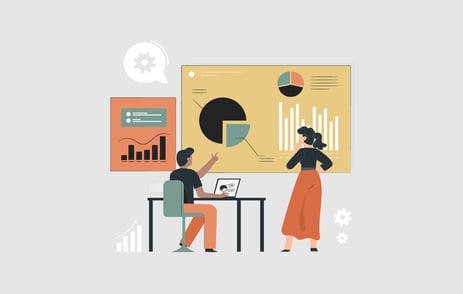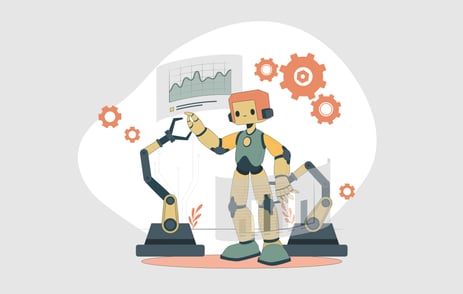In today's digital landscape, associations generate and handle vast amounts of data, ranging from membership information to event registrations and engagement metrics. Yet, amidst this wealth of data, questions regarding ownership, control, and utilization often arise. Associations, like any other entity, can benefit greatly from owning, unifying, and enriching their data. Here’s how.
What is Owned Data and How Can it Benefit Associations?
To reap the benefits of owned data, it’s first important to understand what owned data is. By definition, owned data refers to data that is under the direct control and ownership of an individual or organization. This means that the entity has the legal rights to collect, store, manage, and utilize the data as they see fit, within the bounds of relevant laws and regulations. Owned data contrasts with data that is collected, stored, or controlled by third parties, such as social media platforms or other organizations. Having ownership of data typically entails responsibilities for safeguarding the data's privacy and security.
Data ownership also empowers associations to dictate how their data is collected, stored, and utilized. By exerting control over their data assets and using AI to interpret that data, associations can tailor their strategies and decision-making processes to better serve their members and achieve organizational objectives. Whether it's analyzing membership trends, personalizing communication strategies, or optimizing event planning, owning data enables associations to leverage insights for strategic advantage.
Why Should Associations Unify Their Data?
Data comes from numerous sources, but it's not only limited to your customer relationship management (CRM) system. Some key additional sources of data can include:
- Online communities.
- Surveys.
- Office applications, such as Google or Microsoft.
- Social data.
- Third-party data from the government.
- Purchased data.
However, many associations deal with the issue of siloed data across numerous platforms, making it difficult for AI tools to provide tangible, comprehensive results.
This is where data unification becomes critical. Data unification involves consolidating disparate datasets into a cohesive repository, providing algorithms with access to comprehensive and structured data. This process lays the foundation for advanced analytics and AI applications by eliminating data silos and ensuring consistency across multiple sources. Without data unification, organizations risk fragmented insights and inefficiencies in decision-making processes.
Moreover, data unification enables organizations to gain a holistic view of their operations, customers, and markets, facilitating more informed strategic decisions. By breaking down data silos and integrating information from various systems, organizations can uncover hidden patterns, trends, and correlations that drive innovation and competitive advantage.
Curious about how AI can maximize the impact of your data? Register for our on-demand AI Learning Hub to find out!
%20(2).png?width=315&height=86&name=Untitled%20(600%20x%20400%20px)%20(2).png)
The Importance of Data Enrichment
While data unification brings coherence to disparate datasets, data enrichment adds depth and context to existing information, enhancing its utility and relevance. Traditionally, data enrichment involves augmenting datasets with external sources, such as demographic or geographic data, to provide a more comprehensive understanding of customers or prospects.
However, organizations can also enrich their data internally by leveraging AI algorithms to extract insights directly from existing datasets. For example, AI-driven techniques can be used to structure unstructured data, such as categorizing job titles or standardizing product descriptions, thereby enhancing the quality and usability of the dataset.
By unifying and enriching their data, organizations unlock a myriad of possibilities for advanced analytics, AI applications, and strategic decision-making. With a cohesive and comprehensive dataset at their disposal, associations can:
- Refine marketing strategies and target customers more effectively.
- Improve customer service and personalize user experiences.
- Identify new opportunities for revenue growth and market expansion.
- Optimize operational efficiency and resource allocation.
How Associations Can Unify and Enrich Their Data with Common Data Platforms
Without a doubt, data unification and enrichment play pivotal roles in laying the groundwork for effective AI utilization, enabling organizations to derive actionable insights and drive meaningful outcomes. But how can associations make this a reality?
Common data platforms (CDPs) like MemberJunction can provide the tools associations need to accomplish this goal. An open-source platform designed for any association to use, MemberJunction offers a comprehensive solution for unifying disparate datasets. By integrating data from various sources, such as survey data, content management systems, and CRM systems, MemberJunction centralizes information in one cohesive repository. This process eliminates data silos and ensures consistency across multiple sources, providing algorithms with access to comprehensive and structured data.
Moreover, MemberJunction's metadata-driven architecture enables organizations to build layers of abstraction on top of raw data, enhancing flexibility and customization. Leveraging best-of-breed tools and industry-standard technologies, Member
Junction facilitates seamless integration of diverse datasets, empowering associations to gain a holistic view of their operations, customers, and markets.
In addition to unifying datasets, MemberJunction enriches information with additional context, boosting its utility and relevance. By incorporating enriched data from third-party sources, such as demographic or geographic data, MemberJunction provides a more comprehensive understanding of members or customers. Furthermore, MemberJunction's intelligent code generation capabilities streamline the process of enriching data, reducing the need for manual coding and accelerating deployment.
How Associations Can Unlock the Power of Unified and Enriched Data
With CDPs like MemberJunction, associations unlock a myriad of possibilities for advanced analytics, AI applications, and strategic decision-making. By leveraging a cohesive and comprehensive dataset, organizations can refine marketing strategies, improve customer service, identify new opportunities for revenue growth, and optimize operational efficiency.
For example, it gives associations the power to drive positive change and revenue by:
- Creating personalized member experiences: Data ownership enables associations to personalize member experiences based on individual preferences and behaviors. By segmenting members according to interests, engagement levels, and demographic information, associations can deliver targeted communications, relevant content, and tailored services, enhancing member satisfaction and retention.
- Growing membership and improve retention rates: Understanding member needs and preferences through data analysis can inform membership acquisition and retention strategies. Associations can identify trends, anticipate churn risk, and implement proactive measures to engage at-risk members, strengthen relationships, and increase membership loyalty.
- Optimizing resources: Analyzing data on program performance, resource utilization, and member engagement allows associations to optimize their operations and allocate resources more effectively. By identifying areas of inefficiency or underperformance, associations can reallocate resources, streamline processes, and maximize the impact of their initiatives.
- Encouraging community engagement: Engaging members in data-driven initiatives, such as crowdsourcing ideas or soliciting feedback through surveys, strengthens the sense of community ownership and participation.
- Continuously improve: Data ownership enables associations to adopt a culture of continuous improvement by measuring, monitoring, and evaluating their performance over time. By tracking key performance indicators (KPIs) and benchmarking against industry standards, associations can identify areas for improvement, implement targeted interventions, and measure the effectiveness of their efforts.
Data unification and enrichment are essential steps in harnessing the full potential of data for AI-driven decision-making and innovation. By consolidating disparate datasets, enriching information with additional context, and prioritizing data ownership and interoperability, organizations can build a solid foundation for success in the digital age.
Create a Data-Driven Growth Strategy For Your Association
Owning and unifying your data is only the first step in achieving your association’s growth objectives. The next step involves building a robust strategy around using AI to effectively use that data. But how can you get started? Hit the ground running by registering for our on-demand AI Learning Hub today. This continuously updated course will provide you with the tools you need to leverage AI capabilities to drive your association’s objectives forward.
%20(2).png?width=315&height=86&name=Untitled%20(600%20x%20400%20px)%20(2).png)

February 8, 2024


